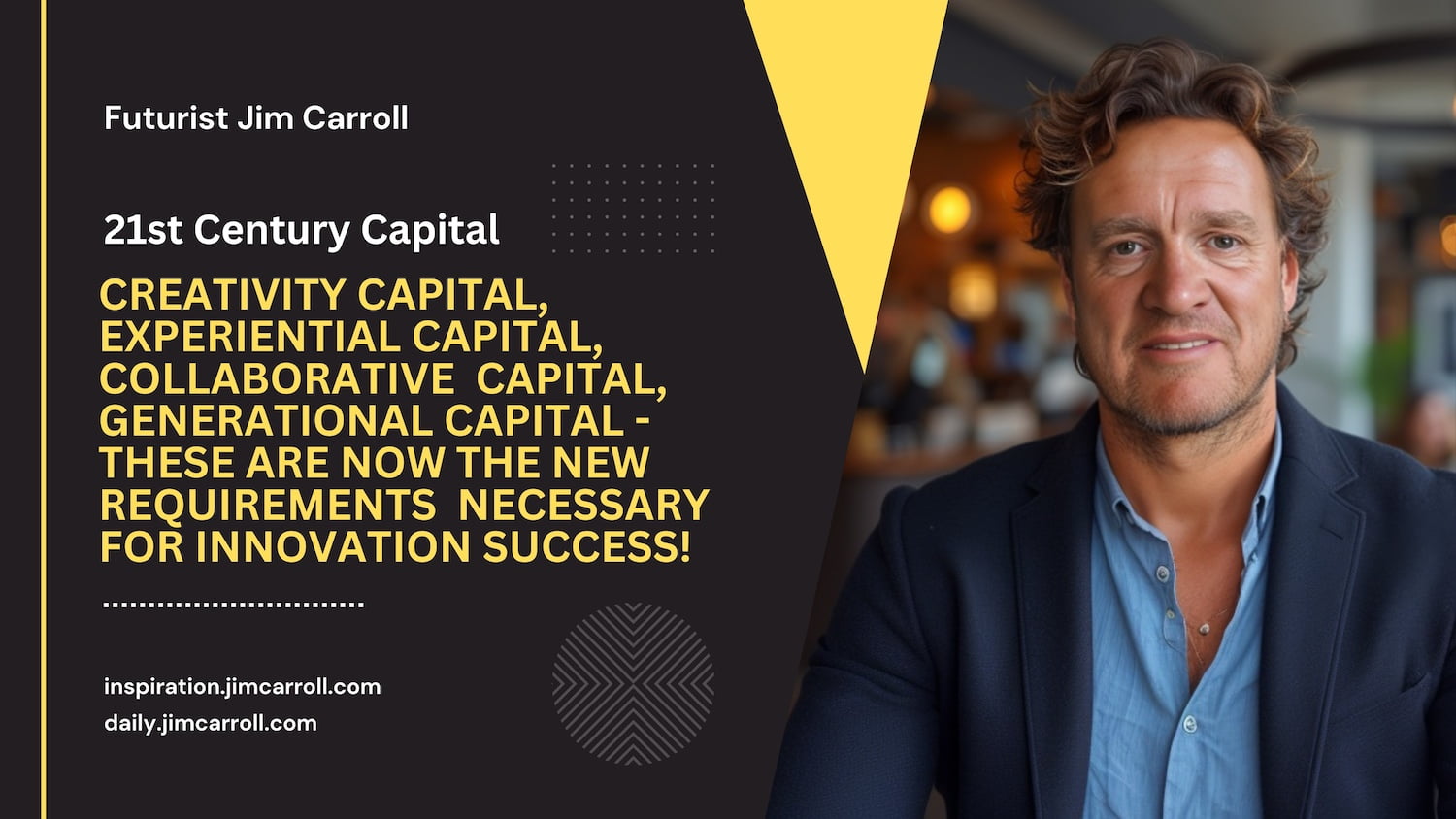“Creativity capital, experiential capital, collaborative capital, generational capital – these are now the new requirements necessary for innovation success!” – Futurist Jim Carroll

Enhance your balance sheet!
You need to understand what’s necessary with 21st-century capital: and why it’s not just financial capital anymore!
In the 20th century, financial capital was the resource of choice. That doesn’t cut it anymore. Today, it’s all about skills, experience, creativity and more. Do you have what it takes? In the 21st century, given the high-velocity economy and the need for agility, organizations will need many different, nontraditional types of capital:
- Experiential Capital. In a world in which Apple generates 60% of its revenue from products that didn’t exist four years ago, it’s critically important that an organization constantly enhance the skills, capabilities, and insight of its people. They do this by constantly working on projects that might have an uncertain return and payback – but which will provide in-depth experience and insight into change. It’s by understanding change that opportunity is defined, and that’s what experiential capital happens to be. In the future, it will be one of the most important assets you can possess.
- Skills Accessibility Capital. Talent, not money, is the new corporate resource for the battlefront. Simply put, there is so much happening that no one person or organization can know everything there is to know. With ongoing rapid knowledge growth, instant market change, fast-paced scientific discovery, and constant skills evolution getting the right people at the right time for the right purpose will be the key to successful change.
- Creativity Capital. It is the ability to see the world differently, and the skill to imagine how to do things differently, that will be more important than any other skill. This will bring the needed forward-oriented depth that organizations require. When product lifecycles are disappearing, and market longevity is measured in weeks and months, the ability to think, adapt, and imagine will be the foundation to provide for necessary change.
- Generational Capital. We are set to see the emergence of the most unique workforce in history, with the widest age span ever. Boomers aren’t retiring, and kids don’t want to get hired but want to be their boss. The result will be a workforce that is transient, temporary, shifting, and flexible. It will be those organizations who can match up the experience and wisdom of the aging baby boomers with the insight, enthusiasm, and change-adept younger generation who will find the most powerful force to be found in business – an organization that is fuelled by the pure energy of change-oxygen.
- Collaborative Capital. Forget the idea of having a strategic planning department, and think collaborative culture instead. Take a look around you, and ask yourself, who is succeeding today? It is those organizations who are plugged into the infinite idea loop that surrounds us. They’ve dropped any pretense that they can create the future, and instead realize that the future is being developed by everyone all around them. They have come to learn that their role isn’t to plan for that future, but simply to listen to it, plug into it, and plug their growth engine into it.
- Complexity Partnership Capital. In the 20th century, organizations focused on hiring the skills that they needed to get the job done. You simply can’t do that today – skills are too fragmented and too specialized. That’s why successful organizations have mastered the art of complex supply and demand. They provide their unique complex skills to those of their partners who need such skills. And when they are short on other skills, they tap into the skills bank of their partners. By selling and buying skills with a broad partnership base, they’ve managed to become complexity partners – organizations that spend most of their time focusing on their core mission, and spend less time worrying about how they are going to do what they need to do.
- Innovation Capital. Companies that understand that all future innovation comes from the ability to tap into the global innovation loop will thrive; those that follow traditional innovation models, self-centered and insular, will find that their creativity and uniqueness have been smothered.
Enhancing your real-world balance sheet with these new elements of capital will prove to increase your innovation capability to a great degree.
What’s the depth of all the different types of capital outlined above?
Do you have the depth of investment necessary to get you through the future?
If not, start to think about how you can start to get some major investment happening!




GET IN TOUCH
Jim's Facebook page
You'll find Jim's latest videos on Youtube
Mastodon. What's on Jim's mind? Check his feed!
LinkedIn - reach out to Jim for a professional connection!
Flickr! Get inspired! A massive archive of all of Jim's daily inspirational quotes!
Instagram - the home for Jim's motivational mind!